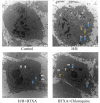Botulinum toxin type A induces protective autophagy in human dermal microvascular endothelial cells exposed to an in vitro model of ischemia/reperfusion injury
- PMID: 30542387
- PMCID: PMC6257827
- DOI: 10.3892/etm.2018.6741
Botulinum toxin type A induces protective autophagy in human dermal microvascular endothelial cells exposed to an in vitro model of ischemia/reperfusion injury
Abstract
Botulinum toxin type A (BTXA) has been reported to increase the survival of ischemic skin flaps; however, the exact mechanism underlying this effect remains unclear and needs to be further established. The present study aimed to elucidate whether autophagy caused by BTXA functions as a protection mechanism and to identify the mechanisms of its regulation by BTXA in human dermal microvascular endothelial cells (HDMECs) subjected to hypoxia/reoxygenation (H/R)-induced injury. HDMECs were harvested from the upper eyelid tissues of female blepharoplasty patients. HDMECs were exposed to BTXA treatment for 12 h and then subjected to hypoxia for 8 h, followed by reoxygenation for 24 h. Chloroquine diphosphate salt (CQ) was used as an autophagy inhibitor. H/R led to extreme injury to the HDMECs as indicated by the rise in the apoptosis rate, which was significantly attenuated by BTXA pretreatment. The outcomes demonstrated that H/R caused autophagy, as evidenced by a higher type II/type I ratio of light chain 3 (LC3), increased expression of Beclin-1 and increased autophagosome formation. BTXA enhanced autophagy and attenuated apoptosis in a dose-dependent manner, whereas CQ attenuated the BTXA antiapoptotic effects and inhibited the formation of autophagolysosomes, which caused clustering of the LC3-II in cells. In conclusion, autophagy promoted by BTXA serves as a potential protective effect on ischemia/reperfusion injury.
Keywords: autophagy; botulinum toxin type A; human dermal microvascular endothelial cells; ischemia/reperfusion injury.
Figures




Similar articles
-
Botulinum toxin type A activates protective autophagy by modulating endoplasmic reticulum stress in hypoxia/reoxygenation-treated endothelial cells.Heliyon. 2023 Jul 9;9(7):e17907. doi: 10.1016/j.heliyon.2023.e17907. eCollection 2023 Jul. Heliyon. 2023. PMID: 37483799 Free PMC article.
-
Botulinum Toxin Type A Attenuates Apoptosis in Human Dermal Microvascular Endothelial Cells Exposed to an In Vitro Model of Ischemia/Reperfusion Injury.Transplant Proc. 2019 Apr;51(3):966-971. doi: 10.1016/j.transproceed.2018.11.006. Epub 2019 Jan 7. Transplant Proc. 2019. PMID: 30878205
-
Extracellular vesicles from hypoxia-pretreated adipose-derived stem cells regulate hypoxia/reoxygenation-induced human dermal microvascular endothelial apoptosis and autophagy in vitro.Heliyon. 2023 Jan 29;9(2):e13315. doi: 10.1016/j.heliyon.2023.e13315. eCollection 2023 Feb. Heliyon. 2023. PMID: 36747525 Free PMC article.
-
Hypoxia Promotes Adipose-Derived Stem Cells to Protect Human Dermal Microvascular Endothelial Cells Against Hypoxia/Reoxygenation Injury.J Surg Res. 2021 Oct;266:230-235. doi: 10.1016/j.jss.2021.04.013. Epub 2021 May 20. J Surg Res. 2021. PMID: 34023579
-
Effect of botulinum toxin type A on flap surgery in animal models: a systematic review and meta-analysis.J Plast Surg Hand Surg. 2022 Aug;56(4):198-207. doi: 10.1080/2000656X.2021.1953044. Epub 2021 Aug 1. J Plast Surg Hand Surg. 2022. PMID: 34338133
Cited by
-
Botulinum toxin type A activates protective autophagy by modulating endoplasmic reticulum stress in hypoxia/reoxygenation-treated endothelial cells.Heliyon. 2023 Jul 9;9(7):e17907. doi: 10.1016/j.heliyon.2023.e17907. eCollection 2023 Jul. Heliyon. 2023. PMID: 37483799 Free PMC article.
-
Hexavalent chromium-induced autophagic death of WRL-68 cells is mitigated by aqueous extract of Cuminum cyminum L. seeds.3 Biotech. 2020 May;10(5):191. doi: 10.1007/s13205-020-02184-7. Epub 2020 Apr 4. 3 Biotech. 2020. PMID: 32269896 Free PMC article.
-
Effects of Botulinum Toxin Type A on the Axial Skin Flap Survival.World J Plast Surg. 2022 Mar;11(1):30-37. doi: 10.52547/wjps.11.1.30. World J Plast Surg. 2022. PMID: 35592220 Free PMC article.
-
Botulinum Toxin Type A Alleviates Androgenetic Alopecia by Inhibiting Apoptosis of Dermal Papilla Cells via Targeting circ_0135062/miR-506-3p/Bax Axis.Aesthetic Plast Surg. 2024 Apr;48(7):1473-1486. doi: 10.1007/s00266-023-03834-w. Epub 2024 Jan 29. Aesthetic Plast Surg. 2024. PMID: 38286898
-
[Research advances on application of botulinum toxin type A in scar prevention and treatment].Zhonghua Shao Shang Yu Chuang Mian Xiu Fu Za Zhi. 2022 Apr 20;38(4):385-388. doi: 10.3760/cma.j.cn501120-20210208-00054. Zhonghua Shao Shang Yu Chuang Mian Xiu Fu Za Zhi. 2022. PMID: 35462519 Free PMC article. Review. Chinese.
References
LinkOut - more resources
Full Text Sources
